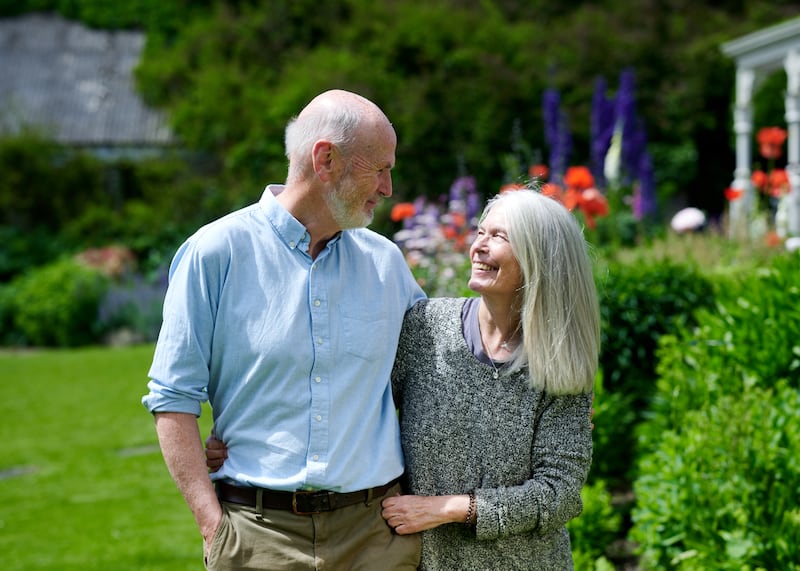Last summer the owner of the Old Ground Hotel in Ennis rang Niall Williams to tell the writer about an American couple staying there. They said they wanted to see the village of Faha. “Tell them it’s an imaginary place,” said Williams, who in his last book, This Is Happiness, wrote about the characters and carryings-on in Faha, a rain-sodden “forgotten elsewhere” in west Co Clare. “I’ve told them it’s not real,” the owner said. “But they still want to go there.”
The couple ended up paying a taxi driver €250 to drive them around the townlands and villages that inspired Faha. Williams is driving us around there now. Before long we pass a man who is walking slowly, slightly hunched, at the side of the road and, further on, a young boy who is leading a pony by a rope. “It’s still here, the life I write about,” Williams says.
Both figures could have come straight from the pages of Time of the Child, his latest Faha-based book. In it we meet many of the characters who populated This Is Happiness, which was set in 1958, as electricity arrived in the village. The story in the new book takes place a few years later. We follow the world-weary parish doctor Jack Troy and his eldest daughter, Ronnie, as they take delivery of an abandoned newborn baby who will transform both their lives. It’s no coincidence that Williams became a grandfather for the first time while writing the book.
Set in December, Time of the Child is a wise, lyrical and funny Christmas fable, full of humanity and joy, that is sure to put Faha and west Clare even more firmly on the literary map.
READ MORE
Unusually, it’s not raining as we drive west, the peninsula narrowing, the Shannon Estuary somewhere out of sight to our left. We’re heading to Kiltumper, to the home Williams shares with his wife and creative partner, the artist, writer and gardener Christine Breen. “Kiltumper is not Faha,” he says as we drive, explaining that Faha is an amalgamation of villages that sit on the estuary.
Having first met in the canteen at University College Dublin, where both were students, Williams and Breen married in her native New York, in 1980, before abandoning the rat race of Manhattan, where he was a copywriter and she a copy editor. In 1985 they set up home in Breen’s ancestral cottage, a poverty-ravaged place her grandfather Joseph had left for the United States in 1906. The four-roomed shack on a lumpy hillside in Kiltumper had been in her family since the mid-1700s. “We wanted to see if we could imagine a more fulfilling life for ourselves,” Williams says. Kiltumper was a long way from Kilmacud, in south Co Dublin, where he grew up.
They spent those early years writing four nonfiction books about their escape to the good life. Back then the local shops didn’t sell bread, as most people made their own, and it took nearly six months to get a wind-up phone installed. It was like A Year in Provence, Williams says, referring to Peter Mayle’s account of moving to southeastern France in the 1980s, “only instead of wine and cheese there was a lot of rain and potatoes and tea”.

Each book made enough money so that they could live for another year in Kiltumper. The proceeds from each book added another room or a conservatory, funded rewiring jobs or paid for the handsome Aga in the dining area. “The books were like letters to the readers. They took it all very personally. It became immediately apparent that we were living the dream of a lot of Americans, to move back to the ancestral cabin and live there.”
The first book was well reviewed in the New York Times, and CBS arrived to film a 20-minute television special about their adventures, which led to American tourists flocking to their home entranced by their story. They counted 300 of them that first summer.
Williams might well be the most successful Irish novelist many have never heard of. When Time of the Child is published, the US print run is expected to be in the hundreds of thousands. Stanley Tucci once appeared at their home – he was charming and entranced by the Aga – wanting to make a film of Williams’s debut novel, Four Letters of Love.
That film, not directed by Tucci in the end but with a screenplay by Williams, and starring Helena Bonham Carter, Pierce Brosnan and Gabriel Byrne, will be out in the spring. Bonnie Raitt, Ann Patchett and Hozier are fans. Yet when I mention the author’s name to several well-read friends before travelling west to meet him it’s mostly a case of “Niall who?”
“It’s a bit of a mystery,” Breen says as we eat lunch at their table in Kiltumper, gazing out on her beautiful garden. “Especially when you think this is novel number 10.”
“I am the great unknown novelist,” Williams says, laughing. “Even after being longlisted for the Booker,” Breen adds, talking about Williams’s first book set in Faha, History of Rain, which was published 10 years ago.
Maybe you don’t do enough literary swanning around, I suggest; does he play the game? “I’m not sure he’s been invited to the game,” Breen says. “I don’t want to play in any games,” Williams says. In any case, he’s shy and public events make him anxious.
“I’m very happy to do nothing at all. I do what I have to do, but it’s not who I am or what I feel comfortable with.” He relates to Sally Rooney’s reticence about publicity. Does he know her? “I know nobody. I know Chris,” he says, smiling over at his wife.
“Every two or three years I’ll hear from Cormac Kinsella,” he says referring to the well-regarded book publicist. “If you hear me on Miriam O’Callaghan you’ll look behind me and there will be Cormac with a gun. That’s how it works.”
The couple have been dealing with health issues. A couple of years ago Williams collapsed with a heart problem. “It was my electrics,” he says as their lively dog, Finn, bounces around the house. “The man who wrote about electricity coming to Faha has problems with electrics,” Breen says with a smile; she has been through a torrid time herself with bowel and skin cancer. When they talk about these challenges I think of Dr Troy in Time of the Child and his wise father’s adage that “the central challenge of life was to accept the world is a place of pain. And yet live. Yet live, Jack.”
Through it all, Williams has been living and writing away quietly. His 10 novels include two books for young adults and an extremely niche-sounding novel called John, about the final years of the apostle. His then editor at Picador, while declaring it a masterpiece, said they couldn’t publish it because it wouldn’t sell. John was eventually published in 2008 by Bloomsbury, “maybe because they had all the money from Harry Potter”, Williams says. John was critically acclaimed but sold “hardly anything”. And then History of Rain was longlisted for the Booker – which, Williams believes, “vindicated Bloomsbury’s faith in John”.
This Is Happiness, from 2019, eventually did almost as well in the US as Four Letters of Love. Patchett made a video about the book and quoted it at length in a recent New York Times essay. The influential critic Ron Charles of the Washington Post wrote a rave. Things really took off during the pandemic. “I think people were missing a sense of community, and they found that in Faha. People weren’t able to travel, but they could travel to Faha in the book.”
Time of the Child is being similarly well received by critics, but Williams says he doesn’t read reviews. He can trace this decision back to the early 1990s, when he wrote his first play, The Murphy Initiative. Mentored by Garry Hynes of Druid theatre company after attending a writing workshop, Williams ended up in the rare position of having his debut play performed on the main stage of the Abbey Theatre. Unfortunately, The Murphy Initiative was panned so badly – “slaughtered” is the word he uses – that it left lasting scars.
It was a big deal. Kiltumper’s parish priest organised a bus for locals to travel to Dublin to see the play. “Having a play on in the Abbey in those days was like making the All-Ireland final in Croke Park,” he says. The morning after the opening night a copy of The Irish Times was presented to him with a flourish by the landlady of the guest house on Raglan Road where he and Breen were staying. Their host hadn’t read the review yet. Opening night was August 15th, 1991, Williams says, the date clearly scorched into his memory.
To hear him tell the full story is to experience second-hand trauma and embarrassment on an almost overwhelming scale. Breen reckons Williams should write a book about it one day. Perhaps he will. Later, I look back in the Irish Times archive and find the review. “Total waste of a bad idea” is the headline. “That was the last review I ever read,” he says.
What did he learn from that experience? “It made me realise you are on your own; you can’t try to please people; you have to do your own thing. I have a vocational sense about writing ... I am here to write the books I’m supposed to write, not the books a reviewer in The Irish Times would like.”
The play was the first piece of work he’d done in Ireland. The nonfiction books about Kiltumper were all published in the US. “I was going to be a playwright,” he says with a smile. In fact, he did go on to write two more plays, but “the best outcome from that experience is that I wrote Four Letters of Love”.
His intention, moving to west Clare, had always been to write a novel. He views his four nonfiction books with Breen as an apprenticeship. “I had to write what was in front of me before going into my imagination.” Four Letters of Love took time to emerge. For four weeks he had only the first sentence, a sequence of words he typed over and over: “When I was 12 years of age, God spoke to my father for the first time.” He didn’t know what the book was about; he never really does. “I only knew that I wanted to write about love.”
Eventually he figured out the second sentence: “God didn’t say much.” What followed was the experience of many artists, “a moment of revelation followed by nothing, a leap forward and a leap back”. In the love story, often described as “Irish magic realism”, a father leaves his family and a Civil Service job to be a painter, believing painting is the job he is put on earth to do. “In a way it captured that common experience of writers and artists, constantly asking, is this the right path?”
Four Letters of Love was published by Picador and edited by Peter Straus. Not bad going for a debut novelist. How did that happen? It turns out Williams was close friends with Marianne Gunn O’Connor, who had a clothes shop on South Anne Street in Dublin at the time. It was Breen who suggested Gunn O’Connor become Williams’s agent, reasoning that “she was the person with the most chutzpah we had ever met,” Williams explains. “It’s magnetism, or something,” Breen says. Gunn O’Connor is no longer his agent. She let him go about 15 years ago. “That’s another story,” Williams says.
He was teaching at a local secondary school while writing Four Letters of Love. He recounts going to Dublin to meet Gunn O’Connor for dinner at Locks restaurant on the Grand Canal, telling her he’d written his first novel and asking if she’d be his agent. She said, “Of course I will. What does an agent do?” Williams made a list of 10 editors in the UK and suggested, “After you get 10 rejections call me, and I will get 10 more.” First on that list was Straus, the most significant editor in London at the time.
As Williams tells it, Gunn O’Connor rang Straus the next day. It was lunchtime, so, with his secretary on a break, Straus himself answered the phone. Gunn O’Connor told him about Niall Williams and about Four Letters of Love, and Straus said she should post him the novel. Gunn O’Connor insisted she wanted to give it to him in person. Straus said that was not possible, as he was flying to New York the following morning. Gunn O’Connor insisted she’d meet him at Heathrow. She flew to London and handed over the manuscript. Straus read it on the plane and bought the book as soon as he got to his hotel in New York.
Gunn O’Connor, who would go on to represent – and carve out huge book deals for – the likes of Cecelia Ahern and, more recently, the journalist Tanya Sweeney, was now an agent. And Niall Williams was now a novelist. Eventually, through word of mouth mostly, the book “was an extraordinary success”, he says.
“I didn’t expect it to be successful commercially or critically, but then that’s not my goal. My goal is to write the books I can write,” he says. He was offered book tours and events but turned most of them down. He had two small children at the time, a boy and girl the couple had adopted, Joseph and Deirdre. “Publishing was different then. There wasn’t the pressure to do everything the way there is now,” he says. Any success was “very removed from our life ... Now, years later, I often encounter people who loved it, but we didn’t know that at the time.”
For years his agent has been Caroline Michel, who also represented the late Edna O’Brien. As soon as Michel heard Williams was agentless she flew from London to Shannon, “in high heels and silks”, to snap up the author. How does she feel about the book? “She thinks it’s the greatest work I’ve ever done, but then she’s a very enthusiastic, supportive person.”
Williams mostly writes in the morning. In the afternoon he likes to be out in the garden with Breen. “She is an artist in the garden. I’m her groundsman.” She is also his first reader and editor. With this new book it took her a while to give her verdict. Eventually it came: “Well, it’s pure Niall Williams,” she said.
“It’s the best possible thing she could have said, because that’s my goal. To try to express my spirit on the page. And get it out there. Through these characters, my feelings, my emotions, which can’t be expressed by anybody else. So ‘pure Niall Williams’ is a kind of completion in a way.”
In April it will be 40 years since the couple moved to west Clare, Williams tells me as we drive back to the station, a turkey sandwich made by Breen in my bag for a snack on the train. Time of the Child is the 20th work they’ll have completed in that time. It feels like the right moment for a small book tour of the United States – he has never done one despite all his success there – and there’s a visit planned to a literary festival in Australia.
As a writer, Williams says, he does not think he will ever leave Faha again. It seems the imaginary village inspired by the place he and Breen have made their home will be the setting for all the novels that are left in him. He thinks back to the tradition of the cuaird, or night visiting, which still happens in the area. You turn up uninvited at someone’s house by the back door, tell them how things are going, the stories of your life, and they give you tea and biscuits. “And you’d get ‘advices’, like when I bought four cows in the early years, not knowing one end of a cow from the other,” he says.
He and Breen have immersed themselves in this rich community, and it’s all there in This Is Happiness and Time of the Child and the novels yet to be written. “It took me a long time to have the confidence to write it in fiction, after living it for years.” Why? “Because Ireland has moved on and the intelligentsia in Ireland has really moved on. So, writing these stories, you were going to be viewed as sentimental, nostalgic ... or people would think it’s not real.”
[ The great Irish books you may never have heard ofOpens in new window ]
He no longer has such concerns, sure now of his own path. He remembers practising his signature at 10 years of age, comparing his scrawl to his father’s accomplished hand. Williams, who with Breen also facilitates regular writer’s workshops, views books as signatures.
“We can only write the books that are our books. And when you realise that, it’s the moment when you recognise you are a chestnut tree, or you are an apple tree.” If it turns out you are a chestnut tree, “sometimes the chestnuts will be good, sometimes they won’t be good, sometimes the wind will take the chestnuts away. But no matter how hard you try you can’t produce apples, so there’s no point looking over at the apple tree.”
Time of the Child is published by Bloomsbury; Niall Williams will be appearing at Leaves Festival of Writing & Music with the musician Mike Hanrahan on Saturday, November 9th



















